Almost everywhere you look around Auckland these days there are new houses being built, in particular single houses making way for multiple townhouses or apartments. There is so much going on that we’re seeing new records being set for building consents.
September saw 1,734 new dwellings consented, the second highest month seen in Auckland since 1990 – as far back as available records go. The only month higher was in October 2002 when a large number of apartments were given consent. But months can fluctuate and so it’s more useful to look at the 12-month rolling trend. That figure reached 15,470 consents, the first time it’s been above 15k.
It’s not just that those consents are happening, it’s also what those consents are for. As we’ve seen in previous updates, it’s denser housing typologies that are driving the numbers and now account for 57% of all consents. Of these it’s townhouses that stand out the most.
This can be seen even clearer if we compare each of these as a line and as you can see, the number of townhouses being consented is rising rapidly.
We can also break these numbers down by Local Board. These figures are for the 12-months to the end of September. My local board, Henderson Massey, has seen the most consents issued followed closely by Papakura and then Howick.
The Council also break down some details of where these consents are located. Their numbers show about 80% of all consents are within the old 2010 Metropolitan Urban Limit. They also compare the locations based on walking distance to rapid transit stations. This shows that just over a quarter of consents are within 1500m walking distance of a rapid transit station. That might not sound like a lot but given our rapid transit network is not all that extensive I doubt a quarter of our urban area is within that definition.
This map is just for September but shows where those 1,734 consents are located.
Of course, consents are one thing but it doesn’t guarantee houses will get built. The council’s data shows that in the 12-months to the end of September just under 13,000 Code of Compliance were issued. This is a drop from a peak of over 14.6k and likely reflects the delays to construction from the COVID lockdowns. Of those completed, about 89% of dwellings were issued consent less than two years ago. These figures are useful to highlight that a high proportion of consents do result in houses being built and do so fairly quickly.
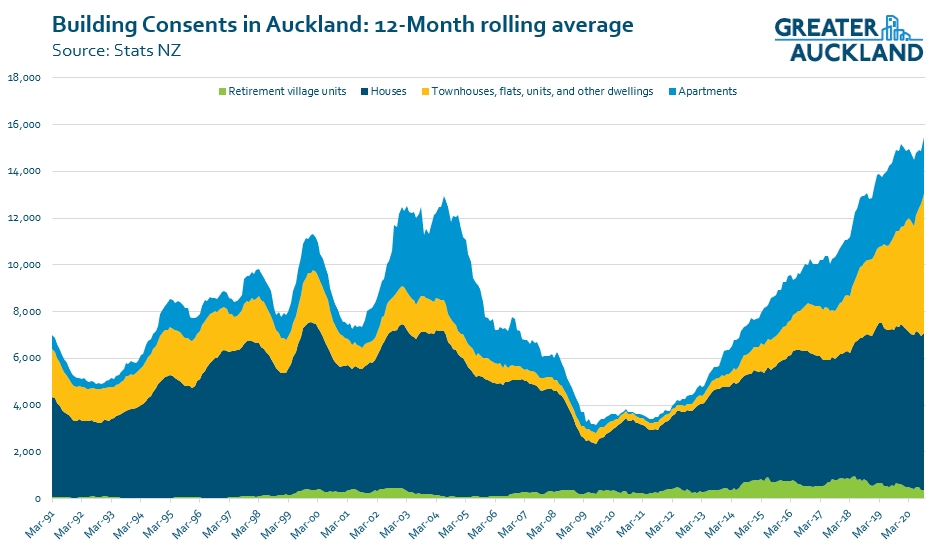
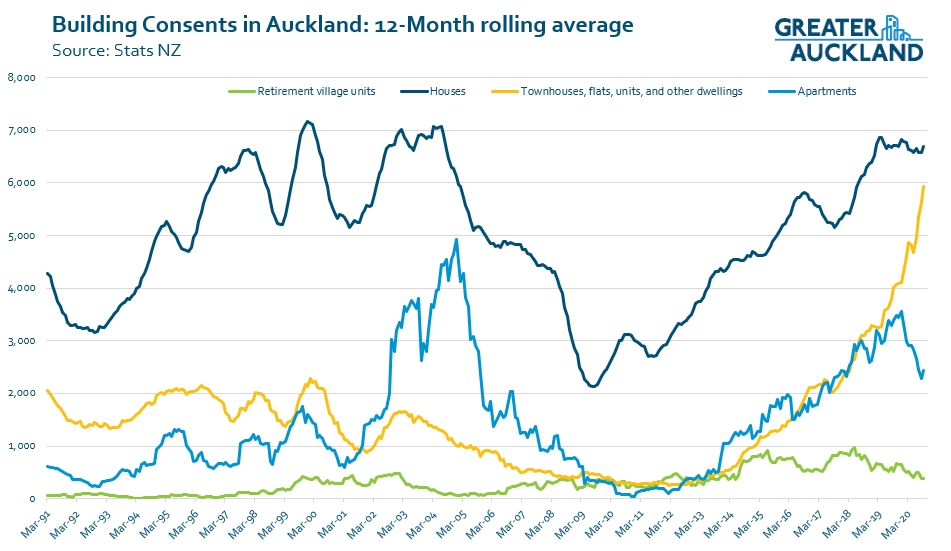
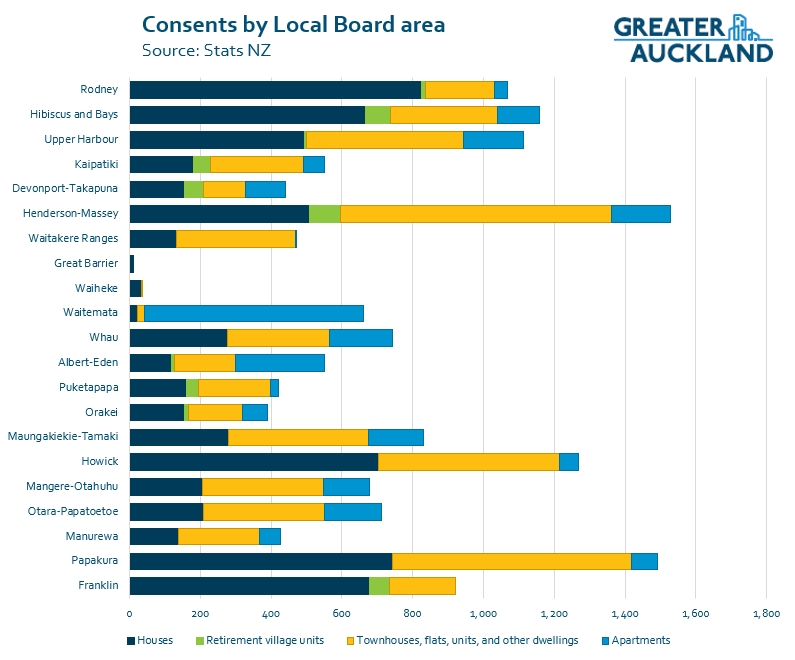
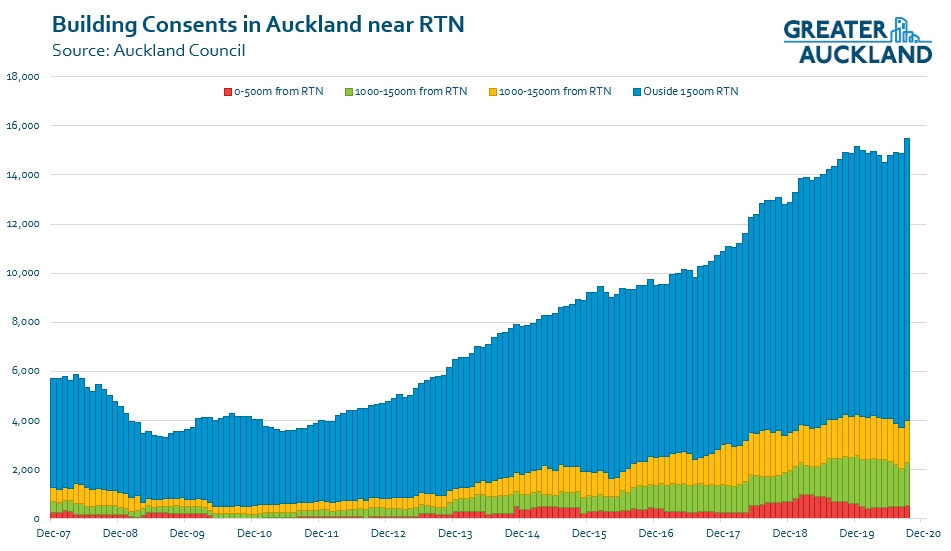
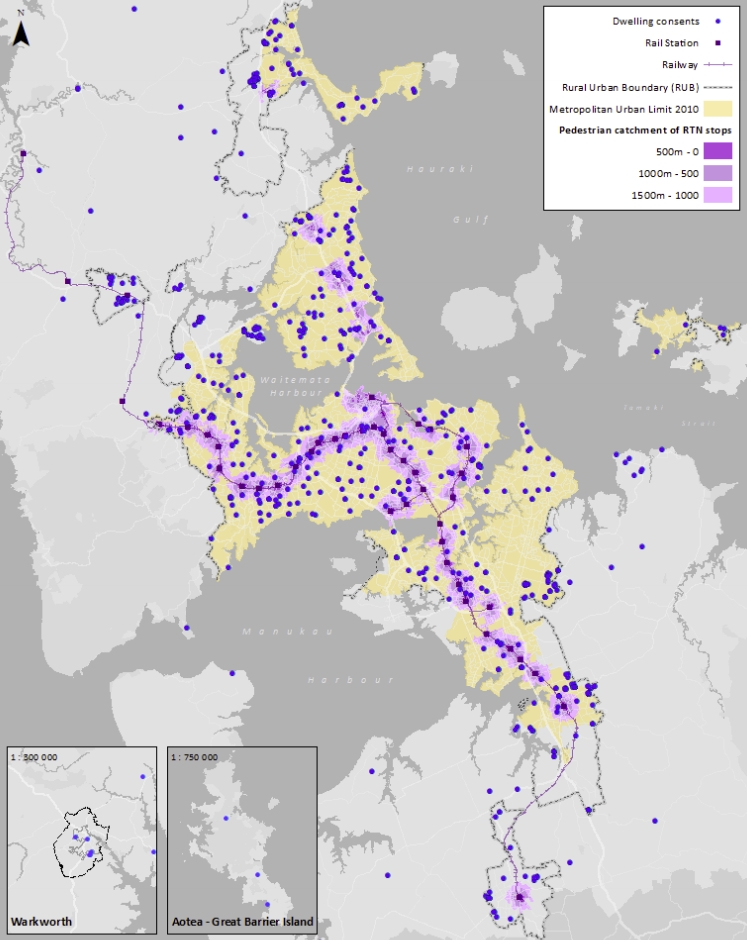

 Processing...
Processing...
These are really good trends, although it seems that house prices are still surging. Maybe if we keep this up for 10 years we might actually get rid of the housing shortage.
It remains to be seen whether this will actually bring down house prices though.
Zero migration during pandemic means well chew through backlog about twelve times faster then pre-pandemic
Denser housing, yes, but at huge prices and in many cases, 20km+ from the city. It’s hard to see how this represents a step forward.
We also seem to be adding a lot of 2 and 3 bedroom homes at median prices or close to it, which is smashing the value of four bedroom houses through the roof. I’d love to see a cost per bedroom breakdown over the last 20 years.
A lot of the stand alone homes being auctioned for huge prices are because of the land value (the development potential of that site). If four bedroom homes are generally on larger sections then that could explain some of the rise is prices. Though there are obviously other reasons they’re desirable too.
In the Mt Wellington area I’m seeing anything on an original quarter acre section sell for $2M+. The old house will be removed and townhouses built in its place.
From what I am seeing, prices for four bedrooms of anything is screamingly high, be it townhouse, apartment or standalone.
Only one option remains, sacrifice one of the kids to the the development gods.
I’ve seen a lot of 4 – 5 bedroom houses being built but often they have small living areas so not that family friendly.
Agree though, 4 bedroom houses go for a lot. I think it is because they were a common type during the leaky home era, which means anything outside of that era attracts a premium.
I think you’re mixing cause and effect.
The construction of 2-3 bedrooms isn’t driving up prices of 4 bedrooms. There’s a general shortage, which is driving up all housing prices. 2-3 bedroom houses represent better value for a lot of home buyers (each additional bedroom offering lower marginal value, but people want room for say a master and 2 kids) so they end up being built.
If we get past this shortage (more houses, less growth in pop, or both) then we’ll probably see developers building 4-5 bedrooms etc to differentiate themselves, but that’s a luxury right now.
Yes we are one of the suburbs having door knockers offering $million + for single dwellings on large site. They are then putting multiple dwellings on site, in one case 11, and still asking for over $800k for 2 bedroom townhouse – or offering them out as rental properties at $780pw. Will be sometime I suppose before this actually leads to lower prices ( if at all)
This is a minor pet peeve – there is no such thing as a “Code of Compliance”. The document issued by councils is a CCC/Triple C – Code Compliance Certificate.
Thanks for coming to my TED Talk.
Cheers – this “Code of Compliance” thing also really irritates me! Yet it’s rife in the media as well as in the general public.
One thing in particular that would speed up a lot of building would be if the council allowed standard pre-approved designs. If these designs could be fast tracked and had reduced fee’s (due to less work being needed) then that would not only speed them up but also reduce costs.
They do, you can get type approval for a standard design. Developers and off the plan housing companies use this, which is why all the houses look the same in new developments.
Do they get reduced charges and a meaningful saving in time and paperwork though?
Also less building inspections for approved and trusted builders building standard approved designs?
or opened up the database for existing approved designs? so you could just copy any previously accepted one. There are obviously plenty of things that are site specific though so there would be a lot of stuff that wouldn’t be able to be approved off the shelf without some planning, but a lot of the work would already be done. I dont know anything about planning though, so perhaps this is already a thing.
I think that Auckland is making good improvements with building different types of housing and building closer to the rapid transit network but it needs to push harder with systemic changes that reengineer the city to grow sustainably around rapid transit and that better supports those most ill served by the housing crisis.
This requires a game plan – with key areas that can be analysed and improved upon – something like;
1. Spatial Planning
2. More Transit Hubs with Concentrated Urban Environments (housing integrated with rapid transit)
3. More Organic Urban Growth
4. Allocate Scarce City Spaces More Efficiently
5. Remove Structural Bias Against Rapid Transit and Multi-Modal Transport
6. Promote an Urban Design Cultural Movement
7. Build Homes for the Full Housing Continuum
Auckland in the last 5 years had a much greater increase in driver numbers (actual numbers not percentage increases) than they did in other multi-modal transport options. Infrastructure in multi-modal options needs to be much more integrated with planning and local government infrastructure provision. We really need to double our efforts in this housing, transport and land-use space. Good discussion on RNZ today.
https://www.rnz.co.nz/national/programmes/ninetonoon/audio/2018771944/huge-rise-in-aucklanders-driving-to-work-vs-bus-or-cycle
Is this surprising when you still can’t walk/cycle over the harbour bridge? 8 lanes for cars, zero for pedestrians/cyclists. Of course people are going to drive when faced with that incentive.
The map that shows where the consents are occurring shows just how important a congestion-free network is to supporting intensification.
The data is clear – rapid transit enables development.
Also shows how we AREN’T developing in areas walkable of the CBD. Highest consents out in West or South Auckland, nothing in Western Suburbs etc, usual story of NIMBYism
15% of new consents within Rapid transit means 85% of the house will be car dependent. Which is not a good number.
Part of the low percentage is because our Rapid transit are not rapid enough to attract more developments. Our Rapid transit are still slower than driving with very low off peak frequency.
If we really wish to have a higher percentage of new dwelling within RTN, the Rapid transit itself must be on par with driving in regards to speed and convivence.
Also another obstacles for higher density around transit is most of the Residential sections near transit are quite small and fragmentated. With restrictive high to boundary rules it become impossible to build anything high on small land.
To solve it we need :
-Better rapid transit
-Ease High to boundary rules in Terrance housing zone.
-Legal framework for easier land consolidation process
I assume you mean ease height to boundary rules.
I agree to all your suggestions.
It’s a quarter of consents within walk of rapid transit. The main factor is the simple fact that the rapid transit walking catchment only covers around 10% of Auckland. for it to get 25% of consents while covering less than 10% of the land is pretty damned good.
You’re assuming only rapid transit can avoid being car dependent, and that walking to rapid transit is the only way people use it. For reference, 73% of public transport in Auckland is on regular buses and ferries.
One bad side-effect putting three dwellings on a former one house site is of greenery. With say three townhouses there’s usually little room left for trees, maybe councils should plant more trees on grass verges.
Yes, and they should also require building site coverage to be low while allowing buildings to go to four storeys.
We won’t achieve a quality built environment if we keep building townhouses and driveways that cover most of the sites. We actually need to decide as a city whether we:
– aim for the perimeter housing block mode at four storeys (higher near arterials and stations), which means individual sites should be able to build side boundary to side boundary, but be required to keep a large permeable back garden, not covered in car infrastructure, or
– achieve some other form, with apartment buildings designed more as a standalone unit, for which the on-site permeable garden space requirement is not so arduous, but the developer needs to contribute towards buying up properties to turn into hyperlocal pocket parks.
Our height to boundary guidelines are preventing either of these so we’re headed towards low rise impermeable, barren sprawl.
This is a really good point Heidi. My preference is the perimeter block development. I am currently in Finland and it is mostly stand alone apartment buildings in the higher density suburban areas (around rapid transit). This is quite inflexible. It is very hard to organically add additional space in response to demand. But a perimeter block built environment may have a mixture of heights say 3 to 6 floors and then additional floors are added later, as needed.
It wouldn’t be hard for NZ to move towards perimeter block development around rapid transit. Height restrictions have been raised to 6 stories and car parking minimums removed. The other major restriction that needs to be removed is the setback and recession plane height to boundary restrictions.
There is two options – a blanket NPS ruling removing them around rapid transit – like the rapid transit 6 story NPS. I suspect this could cause a community/political backlash. The alternative would be to allow neighbouring property owners to negotiate the ‘perimeter block’ upzoning option between themselves. As described here,
https://www.sightline.org/2020/02/28/bottom-up-upzoning/
Agreed.
The current obstacle is liability when one building damage the other building due to fire or earthquake.
The insurance industry may need to catch up, as well as allegations law.
It’s good to see, there are some new developments on Manakau road south of the royal oak roundabout that have kept the established street side trees. I presume they were forced too. But still. It is true that the majority of these developments is totally covered un-permeable surfaces, with everything draining directly to the sewers. So while the city tries to mitigate the effect of streets on k-road for example there are vast areas being covered. Could be mitigated with some permeable concrete, or those concrete grids they used to make driveways out of. The greenery is what makes Auckland great, and the more the merrier.
My new apartment in Panmure either kept the trees, or have had new ones planted on the verge.
The KEA survey suggest 49% of Kiwi expats are coming home in the next few years or 500,000 people. So now isn’t the time to be building houses and selling your land. The price is still going up.
Then again a Covid vaccine might return the rest of the world back to normal much faster than we think. Potential kiwi returnees might then look at the cost of housing in NZ and think – it is just not worth it…
The best financial response is to hold land while it is appreciating at a higher rate that the bank deposit rate. Bank rates are at all time lows so land banking is the rational response right now. All those folks selling to developers are going to struggle to find any investment as good as the one they sold.
Rates should be switched to more heavily weight unimproved land values…
Depends a bit on what you want to use the money for. If it’s investing elsewhere then you are right. However, I’m sure many are looking to maybe cash out their retirement savings.
Sure it will sit in the bank earning bugger all interest but if it’s a larger amount of cash than was previously expected and you’re planning on spending most of it in the next 10 years then that probably doesn’t matter too much.
It’s not just the cost of housing, its the cost of everything else as well. NZ is no longer a low living cost country.
A lot of those kiwis will be in for a huge price shock when they return.
That snippet of information on its own is useless. How many current NZ residents are planning to leave NZ in the same timeframe?
Also the 49% figure is itself questionable. The survey is opt-in, so responses are highly likely to be biased towards those who feel the strongest connection to NZ and are most likely to come back.
I am surprised it isn’t more who want to come back. The world is stuffed. The UK is going to struggle for a good decade post-Brexit, the USA has 70million Trumpists, Australia is run by angry religious people, Europe is going to be ravaged for years by Covid-19 (even if the spruikers are right the new vaccine has a 10% failure rate and immunity that doesn’t last.) We are living in the last paradise where we can pretty much do as we please and where the Government helps out when people are struggling. Our biggest problem will be keeping the influx at a manageable level.
Most of what have described there was happening before Covid. If it wasn’t causing Kiwis to come home in their droves previously I can’t see why it suddenly will now.
The vaccine being ineffective isn’t really beneficial to NZ, it just means at some point we will have to let it become endemic in our population as well.
Thanks Matt – you data junkie. The map of the new 1734 consents is lovely. Unfortunately Great Barrier Island got pasted over my community – im curios to know how we are doing in consents. Do you have a link to the map or data. Thanks again,
Data is published by StatsNZ here: https://www.stats.govt.nz/information-releases/building-consents-issued-september-2020
Dwelling consents over the last year (October 2019 to September 2020),
Waiuku/Glenbrook/Otaua/Manukau Heads:
Houses: 101
Townhouses/Flats: 11
Apartments: 0
Retirement Village Units: 0
Clarks Beach/Waiau Pa:
Houses: 14
Townhouses/Flats: 13
Retirement Village Units: 0
Apartments: 0
The first action of all developers seems to be to remove all greenery from a section, before squeezing on as many townhouses as possible. Generally, this means a garden of established trees gets replaced with a handful of small shrubs.
What does council do with the development contributions? Can it be ring-fenced so that these piecemeal infill developments result in the provision of parks and cycleways for the surrounding areas, or do they just disappear into council coffers and no facilities get provided to cater for the extra population?
I was interested to know the answer to this myself, Bryan, so I asked a few people. It seems that the development contributions go into the overall council funding pool but they can only be used for “proscribed purposes that relate to growth”. And there aren’t usually requirements to spend the contributions in the area where the development occurred.
Now, I don’t have any problem with them going to a different area of Auckland. In theory this could help shift funding from the areas that have received better planning, and more funding, and have more parks, etc, to help regenerate the areas that are really deprived.
But it would be awful if contributions paid for a development that has reduced green infrastructure in a brownfields area are going to fund the green infrastucture amenities in a greenfields area. Those amenities should be being provided as a complete package by the greenfields developer. Using the development contributions there would just be more subsidy to greenfields, at the cost of a liveable city.
And if they’re not even going to green infrastructure amenities, but to support sprawl roads or pipes, etc… that would be hideous.
I was also told that this could be adjusted, and that giving some stakeholder governance could improve the willingness to contribute, with the idea that you can build a lot of support from people who should pay $$ by giving some more formalised opportunity to input. An example given of the sort of approach possible was the accommodation providers’ targeted rate (implemented to offset funding for ATEED). Apparently the accommodation sector can give input proportionate to the contribution. It uses a rating mechanism, so of course, it’s a bit different to development contributions.
Thanks, Heidi. Perhaps we’ll also see some joined-up thinking from council, so that new developments are required to connect new infrastructure to the existing infrastructure, so we don’t end up with missing sections of footpaths, like this one in Ranui where the footpath on the new road stops on the corner of the existing road, some 20m away from the existing footpath.
https://www.google.com/maps/@-36.8724742,174.5934894,3a,75y,59.45h,72.4t/data=!3m6!1e1!3m4!1sCw15dgZcYIYGbcrD2D2l-Q!2e0!7i16384!8i8192
That’s nuts, isn’t it? I’ve seen developers have to provide a cyclelane on one side of the road, one way, but not the cyclelane for going in the other direction, too…
Interesting data. Around our local area Mt Wellington area are a number of more dense townhouses etc and also social housing just completed or in full swing.
Great post Matt; I used to write on this stuff and hopefully I’ll be able to again in the future. I’m really impressed at the number of consents Auckland has gotten to; 15,000+ is huge, especially with the disruption and uncertainty of Covid. And it’s a record breaker of course.
As we’ve discussed, I think we’ll need to start focusing more on *where* the homes are than their typology (houses vs apartments etc). It’s great that Auckland Council is now creating these maps to show consents vs the Rapid Transit Network.